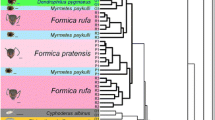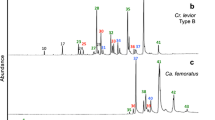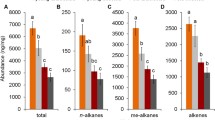Abstract
Myrmecophiles are animals that live in close association with ants and that frequently develop elaborate mechanisms to infiltrate their well-defended host societies. We compare the social integration strategies of two myrmecophilic species, the spider, Gamasomorpha maschwitzi, and the newly described silverfish, Malayatelura ponerophila gen. n. sp. n., into colonies of the ponerine army ant, Leptogenys distinguenda (Emery) (Hymenoptera: Formicidae). Both symbionts use chemical mimicry through adoption of host cuticular hydrocarbons. Exchange experiments between L. distinguenda and an undetermined Leptogenys species demonstrate that reduced aggression toward alien ants and increased social acceptance occurred with individuals of higher chemical similarity in their cuticular hydrocarbon profiles. We found striking differences in chemical and behavioral strategies between the two myrmecophiles. Spider cuticular hydrocarbon profiles were chemically less similar to the host than silverfish profiles were. Nevertheless, spiders received significantly fewer attacks from host ants and survived longer in laboratory colonies, whereas silverfish were treated with high aggression and were killed more frequently. When discovered and confronted by the host, silverfish tended to escape and were chased aggressively, whereas spiders remained in contact with the confronting host ant until aggression ceased. Thus, spiders relied less on chemical mimicry but were nevertheless accepted more frequently by the host on the basis of behavioral mechanisms. These findings give insights into the fine tuning of social integration mechanisms and show the significance of qualitative differences among strategies.







Similar content being viewed by others
References
Allan, R. A., Capon, R. J., Brown, W. V., and Elgar, M. A. 2002. Mimicry of host cuticular hydrocarbons by salticid spider Cosmophasis bitaeniata that preys on larvae of tree ants Oecophylla smaragdina. J. Chem. Ecol. 28:835–848.
Blumer, M., Mullin, M. M., and Guillard, R. L. 1970. Polyunsaturated hydrocarbon (3,6,9,12,15,18-heneicosahexaene) in the marine food web. Mar. Biol. 6:226–235.
Carlson, D. A., Roan, C. S., Yost, R. A., and Hector, J. 1989. Dimethyl disulfide derivatives of long chain alkenes, alkadienes, and alkatrienes for gas chromatography/mass spectrometry. Anal. Chem. 61:1564–1571.
Carlson, D. A., Bernier, U. R., and Sutton, B. D. 1998. Elution patterns from capillary GC for methyl-branched alkanes. J. Chem. Ecol 24:1845–1865.
Clarke, K. R. 1999. Nonmetric multivariate analysis in community-level ecotoxicology. Environ. Toxicol. Chem. 18:118–127.
Cushing, P. E. 1997. Myrmecomorphy and myrmecophily in spiders: a review. Fla. Entomol. 80:165–193.
Dettner, K., and Liepert, C. 1994. Chemical mimicry and camouflage. Annu. Rev. Entomol. 39:129–154.
Elgar, M. A., and Allan, R. A. 2004. Predatory spider mimics acquire colony-specific cuticular hydrocarbons from their ant model prey. Naturwissenschaften 91:143–147.
Elgar, M. A., and Allan, R. A. 2006. Chemical mimicry of the ant Oecophylla smaragdina by the myrmecophilous spider Cosmophasis bitaeniata: is it colony-specific? J. Ethol. 24:239–246.
Francis, G. W., and Veland, K. 1981. Alkylthiolation for the determination of double-bond positions in linear alkenes. J. Chromatogr. 219:379–384.
Goff, L. J. 1982. Symbiosis and parasitism: another viewpoint. BioScience 32:255–256.
Gotwald, W. H. 1995. Army ants—the biology of social predation. Cornell University Press, Ithaca, NY, USA.
Hefetz, A. 2007. The evolution of hydrocarbon pheromone parsimony in ants (Hymenoptera: Formicidae)—interplay of colony odor uniformity and odor idiosyncrasy. Myrmecol. News 10:59–68.
Hölldobler, B., and Wilson, E. O. 1990. The ants. The Belknap Press of Harvard University Press, Cambridge, MA.
Howard, R. W., and Blomquist, G. J. 2005. Ecological, behavioral, and biochemical aspects of insect hydrocarbons. Annu. Rev. Entomol. 50:371–393.
Karunen, P. 1974. Moss spores. III. Polyunsaturated hydrocarbons from Polytrichum commune spores. Phytochemistry 13:2209–2213.
Kistner, D. H. 1982. The social insects’ bestiary, pp. 1–244, in H. R. Hermann (eds.). Social InsectsAcademic, New York, NY.
Leal, W. S., Parra-Pedrazzoli, A. L., Kaissling, K. E., Morgan, T. I., Zalom, F. G., Pesak, D. J., Dundulis, E. A., Burks, C. S., and Higbee, B. S. 2005. Unusual pheromone chemistry in the navel orangeworm: novel sex attractants and a behavioral antagonist. Naturwissenschaften 92:139–146.
Lenoir, A., Malosse, C., and Yamaoka, R. 1997. Chemical mimicry between parasitic ants of the genus Formicoxenus and their host Myrmica (Hymenoptera, Formicidae). Biochem. Syst. Ecol. 25:379–389.
Lenoir, A., D'Ettorre, P., Errard, C., and Hefetz, A. 2001. Chemical ecology and social parasitism in ants. Annu. Rev. Entomol. 46:573–599.
Leonhardt, B. A., and Devilbiss, E. D. 1985. Separation and double-bond determination on nanogram quantities of aliphatic monounsaturated alcohols, aldehydes and carboxylic acid methyl esters. J. Chromatogr. 322:484–490.
Maschwitz, U., Steghaus-Kovac, S., Gaube, R., and Hänel, H. 1989. A South East Asian ponerine ant of the genus Leptogenys (Hym., Form.) with army ant life habits. Behav. Ecol. Sociobiol. 24:305–316.
Reese, K. M. 1982. Chemistry helps beetles live in fire ants' nests. Chem Eng News 30:44.
Rettenmeyer, C. W. 1963. The behavior of Thysanura found with army ants. Ann. Entomol. Soc. Am. 56:170–174.
Schulz, S. 2001. Composition of the silk lipids of the spider Nephila clavipes. Lipids 36:637–647.
Schulz, S., and Nishida, R. 1996. The pheromone system of the male danaine butterfly, Idea leuconoe. Bioorg. Med. Chem. 4:341–349.
Soroker, V., Vienne, C., and Hefetz, A. 1995. Hydrocarbon dynamics within and between nestmates in Cataglyphis niger (Hymenoptera: Formicidae). J. Chem. Ecol. 21:365–378.
Steiger, S., Peschke, K., Francke, W., and Mueller, J. K. 2007. The smell of parents: breeding status influences cuticular hydrocarbon pattern in the burying beetle Nicrophorus vespilloides. Proc. R. Soc. Lond. B. Biol. Sci. 274:2211–2220.
Vender Meer, R. K., and Wojcik, D. P. 1982. Chemical mimicry in the myrmecophilous beetle Myrmecaphodius excavaticollis. Science 218:806–808.
Vane-Wright, R. I. 1976. A unified classification of mimetic resemblances. Biol. J. Linn. Soc. 8:25–56.
Vincenti, M., Guglielmetti, G., Cassani, G., and Tonini, C. 1987. Determination of double bond position in diunsaturated compounds by mass spectrometry of dimethyl disulfide derivatives. Anal. Chem. 59:694–699.
Witte, V. 2001. Organisation und Steuerung des Treiberameisenverhaltens bei Südostasiatischen Ponerinen der Gattung Leptogenys. Ph.D. dissertation. Frankfurt/Main: J. W. Goethe-Universität.
Witte, V., Leingärtner, A., Sabaß, L., Hashim, R., and Foitzik, S. 2008. Symbiont microcosm in an ant society and the diversity of interspecific interactions. Anim. Behav. 76:1477–1486.
Wunderlich, J. 1994. Beschreibung bisher unbekannter Spinnenarten und -Gattungen aus Malaysia und Indonesien (Arachnida: Araneae: Oonopidae, Tetrablemidae, Telemidae, Pholcidae, Linyphiidae, Nesticidae, Theridiidae und Dictynidae). Beitr. Araneol. 4:559–580.
Youngblood, W. W., Blumer, M., Guillard, R. L., and Fiore, F. 1971. Saturated and unsaturated hydrocarbons in marine benthic algae. Mar. Biol. 8:190–201.
Acknowledgments
We are grateful for the financial support from the DFG (Deutsche Forschungsgemeinschaft); Project WI 2646/3-1. We thank K. Staudt, K. Ortner, S. Schreyer, and A. Fenzel for assistance in the field.
Author information
Authors and Affiliations
Corresponding author
Electronic supplementary material
Below is the link to the electronic supplementary material.
ESM
(DOC 96.0 KB)
Rights and permissions
About this article
Cite this article
Witte, V., Foitzik, S., Hashim, R. et al. Fine Tuning of Social Integration by Two Myrmecophiles of the Ponerine Army Ant, Leptogenys distinguenda . J Chem Ecol 35, 355–367 (2009). https://doi.org/10.1007/s10886-009-9606-8
Received:
Revised:
Accepted:
Published:
Issue Date:
DOI: https://doi.org/10.1007/s10886-009-9606-8




